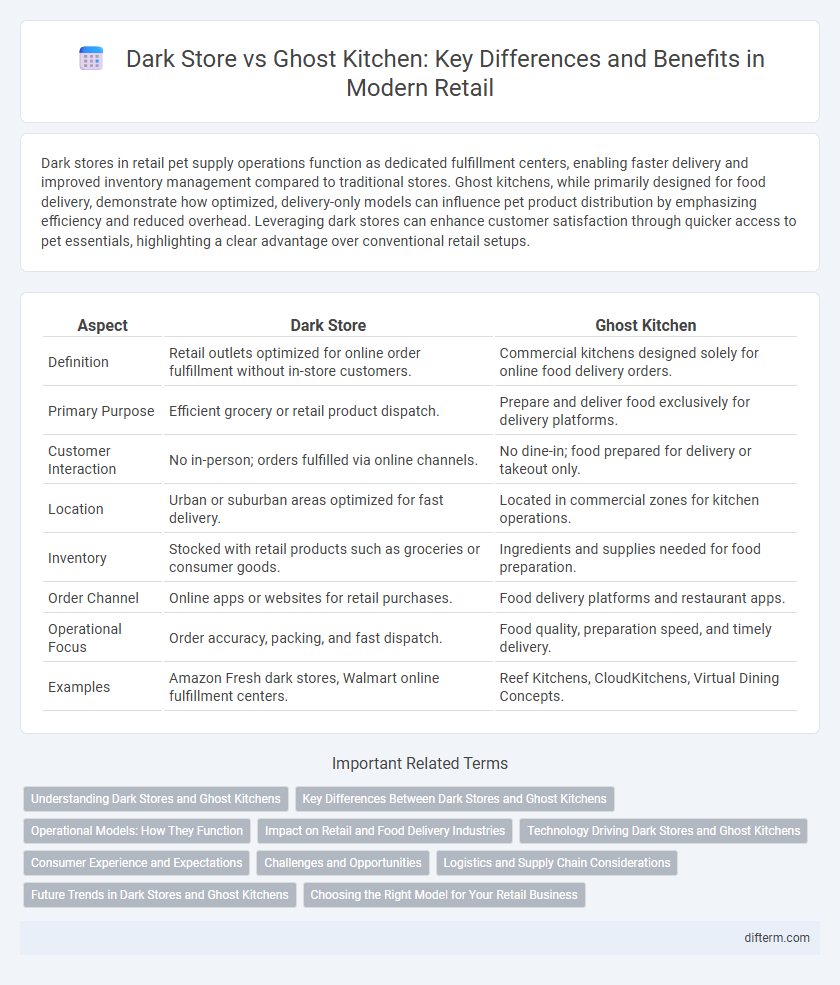Dark stores in retail pet supply operations function as dedicated fulfillment centers, enabling faster delivery and improved inventory management compared to traditional stores. Ghost kitchens, while primarily designed for food delivery, demonstrate how optimized, delivery-only models can influence pet product distribution by emphasizing efficiency and reduced overhead. Leveraging dark stores can enhance customer satisfaction through quicker access to pet essentials, highlighting a clear advantage over conventional retail setups.
Table of Comparison
| Aspect | Dark Store | Ghost Kitchen |
|---|---|---|
| Definition | Retail outlets optimized for online order fulfillment without in-store customers. | Commercial kitchens designed solely for online food delivery orders. |
| Primary Purpose | Efficient grocery or retail product dispatch. | Prepare and deliver food exclusively for delivery platforms. |
| Customer Interaction | No in-person; orders fulfilled via online channels. | No dine-in; food prepared for delivery or takeout only. |
| Location | Urban or suburban areas optimized for fast delivery. | Located in commercial zones for kitchen operations. |
| Inventory | Stocked with retail products such as groceries or consumer goods. | Ingredients and supplies needed for food preparation. |
| Order Channel | Online apps or websites for retail purchases. | Food delivery platforms and restaurant apps. |
| Operational Focus | Order accuracy, packing, and fast dispatch. | Food quality, preparation speed, and timely delivery. |
| Examples | Amazon Fresh dark stores, Walmart online fulfillment centers. | Reef Kitchens, CloudKitchens, Virtual Dining Concepts. |
Understanding Dark Stores and Ghost Kitchens
Dark stores are retail outlets or distribution centers optimized exclusively for online order fulfillment, enabling faster delivery by minimizing in-store customer traffic. Ghost kitchens operate solely as food preparation facilities without dine-in options, fulfilling online food orders across multiple brands from a single location. Both models leverage technology and centralized operations to enhance efficiency in the e-commerce and food delivery sectors.
Key Differences Between Dark Stores and Ghost Kitchens
Dark stores operate as retail distribution centers focused on fulfilling online grocery or retail orders efficiently, using optimized inventory management and rapid order processing systems. Ghost kitchens are commercial cooking facilities designed exclusively for preparing food for delivery, leveraging multiple restaurant brands without a traditional dine-in setup. The key differences lie in their core functions: dark stores emphasize retail product supply chain optimization, while ghost kitchens prioritize streamlined food production and delivery logistics.
Operational Models: How They Function
Dark stores operate as fulfillment centers exclusively handling online retail orders, optimizing inventory management and rapid delivery within defined urban areas. Ghost kitchens specialize in food preparation, functioning without a traditional storefront to serve multiple restaurant brands through delivery-only models. Both leverage technology-driven workflows but differ fundamentally in product scope and logistical coordination.
Impact on Retail and Food Delivery Industries
Dark stores optimize retail fulfillment by transforming retail spaces into dedicated order preparation hubs, significantly reducing last-mile delivery times and enhancing inventory accuracy. Ghost kitchens revolutionize the food delivery industry by operating solely for online orders, enabling restaurants to scale rapidly without dine-in costs and expanding market reach through multiple virtual brands. Both models drive efficiency and innovation, reshaping consumer expectations and operational frameworks in retail and food delivery sectors.
Technology Driving Dark Stores and Ghost Kitchens
Advanced technologies such as AI-driven inventory management, real-time data analytics, and automated order processing are revolutionizing dark stores and ghost kitchens by enhancing efficiency and reducing operational costs. Robotics and IoT-enabled devices facilitate seamless stock replenishment and optimized kitchen workflows, enabling faster delivery times and improved customer satisfaction. Cloud-based platforms integrate order management and delivery logistics, allowing these retail formats to scale swiftly and adapt to dynamic consumer demands.
Consumer Experience and Expectations
Dark stores optimize consumer experience by offering faster delivery times and extensive product availability, meeting increasing expectations for convenience in retail. Ghost kitchens enhance food delivery with specialized, streamlined menus designed for quick preparation, aligning with consumer demands for fresh, diverse meal options. Both models leverage digital ordering to provide seamless, efficient service that reshapes traditional retail and dining experiences.
Challenges and Opportunities
Dark stores face challenges such as high real estate costs and complex inventory management but offer opportunities like faster delivery times and enhanced customer convenience. Ghost kitchens struggle with brand recognition and customer acquisition, yet capitalize on lower overhead expenses and the ability to rapidly test new food concepts. Both retail models leverage e-commerce trends, requiring strategic integration of technology to maximize operational efficiency and market reach.
Logistics and Supply Chain Considerations
Dark stores optimize last-mile delivery logistics by serving as localized fulfillment centers exclusively for online orders, reducing delivery times and enhancing supply chain efficiency. Ghost kitchens streamline supply chains by centralizing food preparation without dine-in facilities, minimizing inventory carrying costs and enabling rapid menu updates. Both models rely heavily on advanced inventory management systems and real-time data analytics to optimize route planning, reduce operational costs, and improve order accuracy.
Future Trends in Dark Stores and Ghost Kitchens
Dark stores are rapidly evolving with increased integration of AI-powered inventory management and robotics to enhance order fulfillment speed and accuracy. Ghost kitchens are expanding through partnerships with multiple delivery platforms, leveraging data analytics to optimize menu offerings and reduce operational costs. The convergence of these models is fostering hybrid retail environments that prioritize seamless omnichannel experiences and last-mile delivery efficiency.
Choosing the Right Model for Your Retail Business
Choosing the right model for your retail business depends on whether your priority is efficient order fulfillment or expanding food delivery services. Dark stores optimize inventory management and quick delivery by functioning as dedicated fulfillment centers for online retail orders. Ghost kitchens focus on lowering overhead by operating delivery-only food preparation without the need for a customer-facing storefront, ideal for expanding restaurant reach within the digital food market.
dark store vs ghost kitchen Infographic

 difterm.com
difterm.com